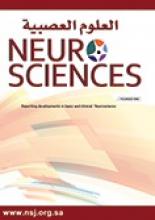Abstract
Objectives: Characterization of the phenotypic, pathological, radiological, and genetic findings in 2 Saudi Arabian families with anoctaminopathies, and limb girdle muscular dystrophy type 2L (LGMD2L).
Methods: Over a 2-year period from December 2010 to January 2013, the clinical presentations were analyzed and all genes responsible for limb girdle muscular dystrophy (LGMD) were screened in families seen at King Faisal Specialist Hospital and Research Centre, a tertiary care hospital in Riyadh, Saudi Arabia. Out of 66 families with LGMD, we identified 2 families (3.1%) with anoctaminopathy, ANO5 muscular dystrophy.
Results: In the first case, a man presented with asymmetrical calves’ muscles weakness and atrophy, which was first noted at age 39. The creatinine kinase (CK) level was >20x normal, muscle biopsy showed necrotizing myopathic changes, and an MRI of the legs showed fatty-tissue replacement to muscle tissue with volume loss involving the gastrocnemius and soleus muscles in an asymmetrical fashion. Minimal disease progression was noted over 18 years of follow up. Exercise induced recurrent rhabdomyolysis was noted over the last 2 years. A novel ANO5 gene mutation (Arg58Trp) was found. In the second family, a male presented at the age of 41 with asymptomatic hyperCkemia and intermittent dyspnea. Over 10 years follow up, he became disabled with muscle cramps, rhabdomyolysis, myoglobinurea, and difficulty ambulating. Muscle biopsy showed necrotizing myopathy and perivascular and interstitial amyloid deposit in skeletal muscle. A homozygous deletion of 11.9 Kb encompassing exon 13 to exon 17 was found in the ANO5 gene. Full cardiac investigations were normal in both patients.
Conclusion: The prevalence of LGMD2L is approximately 3.1% in a Saudi Arabian native LGMD cohort. Slowly progressive, late onset, and asymmetrical weakness was the salient features in these 2 families. The genetic findings were novel and will add to the spectrum of ANO5 known mutations.
Footnotes
Disclosure
Funding was received from King Abdulaziz City for Science and Technology Research No. 08-MED498-20.
- Received August 27, 2014.
- Accepted March 16, 2015.
- Copyright: © Neurosciences
Neurosciences is an Open Access journal and articles published are distributed under the terms of the Creative Commons Attribution-NonCommercial License (CC BY-NC). Readers may copy, distribute, and display the work for non-commercial purposes with the proper citation of the original work.






